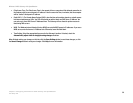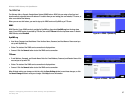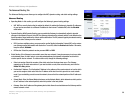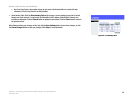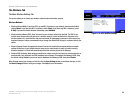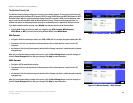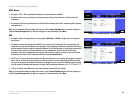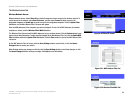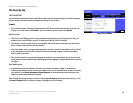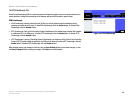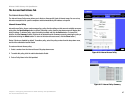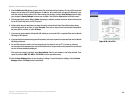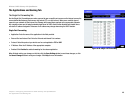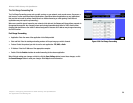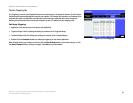
44
Chapter 6: Configuring the Wireless-G ADSL Gateway with SpeedBooster
The Wireless Tab
Wireless-G ADSL Gateway with SpeedBooster
The Advanced Wireless Settings Tab
You can access the advanced wireless features on this screen.
Advanced Wireless
Wireless-G Settings
• Authentication Type. The default is set to Auto, which allows Open System and Shared Key authentication. For
Open System authentication, the sender and the recipient do not use a WEP key for authentication but can
use WEP for data encryption. For Shared Key authentication, the sender and recipient use a WEP key for both
authentication and data encryption. To only allow Shared Key authentication, select Shared Key. In most
cases, you should keep the default setting, Auto, because some clients cannot be configured for Shared Key.
• Control Tx Rates. The default transmission rate is Auto. The rate should be set depending on the speed of
your wireless network. Select from a range of transmission speeds, or keep the default setting, Auto, to have
the Gateway automatically use the fastest possible data rate and enable the Auto-Fallback feature. Auto-
Fallback will negotiate the best possible connection speed between the Gateway and a wireless client.
• Beacon Interval. The default value is 100. The Beacon Interval value indicates the frequency interval of the
beacon. A beacon is a packet broadcast by the Gateway to synchronize the wireless network.
• DTIM Interval. The default value is 1. This value indicates the interval of the Delivery Traffic Indication
Message (DTIM). A DTIM field is a countdown field informing clients of the next window for listening to
broadcast and multicast messages. When the Gateway has buffered broadcast or multicast messages for
associated clients, it sends the next DTIM with a DTIM Interval value. Its clients hear the beacons and awaken
to receive the broadcast and multicast messages.
• Fragmentation Threshold. This value should remain at its default setting of 2346. It specifies the maximum
size for a packet before data is fragmented into multiple packets. If you experience a high packet error rate,
you may slightly increase the Fragmentation Threshold. Setting the Fragmentation Threshold too low may
result in poor network performance. Only minor modifications of this value are recommended.
• RTS Threshold. This value should remain at its default setting of 2346. If you encounter inconsistent data
flow, only minor modifications are recommended. If a network packet is smaller than the preset RTS
threshold size, the RTS/CTS mechanism will not be enabled. The Gateway sends Request to Send (RTS)
frames to a particular receiving station and negotiates the sending of a data frame. After receiving an RTS, the
wireless station responds with a Clear to Send (CTS) frame to acknowledge the right to begin transmission.
When finished making your changes on this tab, click the Save Settings button to save these changes, or click
the Cancel Changes button to undo your changes. Click Help for more information.
Figure 6-23: Advanced Wireless Settings



